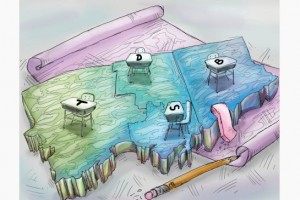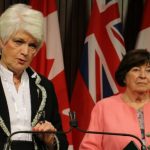De-amalgamating TDSB?
Too big, too unwieldly and utterly dysfunctional. For years, such criticism has been levelled against the Toronto District School Board — one of the largest in North America, the biggest in Canada and nearly twice the size of the next biggest Ontario board.
Forged from six former Toronto boards in 1998 by an amalgamation that still appears strained, experts have long suggested a return to smaller units would be an improvement.
In 2007, trustees themselves talked about de-amalgamation, and in 2008, Kathleen Wynne, then education minister, told the board it needed to change. A report at the time suggested a few models, from two boards to four that would each cover a quadrant in the city — anything to bring a sense of small.
Senior government officials confirm the issue is still on the radar of Wynne — now premier — because the Liberals believe the board is too unmanageable and may need to be broken in two.
But would breaking up be hard to do? How could the schools be divvied up? Would it solve the board’s ongoing problems?
Last November, the education ministry appointed Margaret Wilson to examine problems at the board, including “how the government should conduct a consultation about possible improvements to the governance structure at the TDSB that could promote student achievement and well-being, increase accountability and enhance public confidence.”
In short, could the ailing TDSB be surgically separated without harming the patient? Wilson’s report is due this week.
In 2008, Wynne said the board’s size didn’t allow it to operate “in an agile way,” that standardized test scores were slow to improve compared to most other boards, and that decision-making at the top was difficult, something she knew first-hand as a former Toronto trustee.
Today, the 22 trustees with their own agendas and personal disagreements oversee 250,000 students in more than 550 schools, and coming to any consensus — even just getting along with each other, and staff — has proved to be a tall order.
Some trustees have admitted that even when personal and political divisions are set aside, they find the board too big to handle. Consensus among them is difficult, and the cultures of the former boards haven’t always melded well, they say.
Yet John Campbell, who chaired the board in 2008, doesn’t agree the board has always been dysfunctional. When Wynne called for change back then, trustees formed a committee and addressed the province’s concerns, he said; creating “families of schools” to bring a sense of community.
“You could make the board smaller, but you still have to pick the right leaders — and that’s the only problem the board has,” referring to ongoing controversies involving former chair Chris Bolton and criticisms of current Director of Education Donna Quan.
Breaking up the board is “a common, simplistic reaction to problems the board has had with governance,” added Campbell, now a city councillor. “It’s not too big.”
Former Ontario deputy minister of education Charles Pascal believes it’s more than just a matter of size.
“The Toronto Catholic board has 12 trustees, and why can’t they attract and retain outstanding directors?” he said of the high turnover at the top in recent years.
“They have a real problem over there, problems that aren’t visible” despite having little more than half the number of elected officials as the Toronto public board.
Pascal, now a professor at the University of Toronto’s education faculty, is pushing the province to consider other models for running school boards, including appointing members with specific areas of expertise in finance or education.
Gerald Galway, an education professor at Memorial University in Newfoundland, said he’s not heard of de-amalgamation of any school board, but noted research has shown amalgamation can be disruptive.
There is mixed research on the ideal size of a school board.
Michael Barrett, who heads the Ontario Public School Boards’ Association, said while the sheer size of the Toronto board leads to problems, the main issue is trustees “getting involved in operational matters which should be left to staff.”
“It’s also politics — you have 22 trustees — you have the size of the board, and you have some very strong personalities.”
With files from Robert Benzie and Louise Brown
Learning how to divide
Among suggestions made in 2008 by the education ministry to break up the Toronto District School Board:
- Keep one large, umbrella board but create wards for Etobicoke-York, North York, Toronto-East York, and Scarborough with their own half-dozen trustees and director of education.
- De-amalgamate the board into smaller boards in one of two ways:
—Two separate boards, east and west, divided as equal as possible by number of students or schools
— Four separate boards, northwest, northeast, southwest and southeast, each with roughly 100-150 schools.



